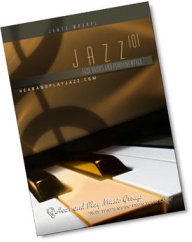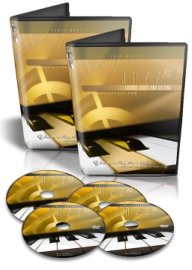Ear Training
Ear Training is a skill that can be learned; it will help you identify various musical elements, such as pitches, intervals, melody, chords, scales etc. Musicians practice this skill all the time. They realize that you can only perform or create music as well as you can hear; and, you can only enjoy and appreciate music as well as you can hear. Listening very carefully to music, either consciously or unconsciously always pays off with better listening skills and a better ear!
In order to determine the notes in a melody, you must have some ability to recognize intervals. Many people relate each interval to the first 2 notes of a familiar song. Here are some examples for each interval:
- unison - Oh, Beautiful... (America)
- m2 - theme from JAWS
- M2 - Strangers in the Night
- m3 - Greensleeves
- M3 - O When (the Saints Go Marching In
- P4 - Amazing Grace
- +4 - Maria (West Side Story)
- P5 - Twinkle Twinkle Little Star
- m6 - A Day In The Life Of A Fool
- M6 - NBC theme
- m7 - Somewhere (West Side Story)
- M7 - 1st & 3rd notes of Bali Hai (South Pacific)
- octave - Somewhere Over the Rainbow
In addition to identifying the melody of a song, it's important to recognize the chords that support it. This can be done by practicing, and listening to different types of chords and their inversions, out of context, just to hear the characteristic sound of the chord.
Then practice and learn chord progressions to hear how chords relate to one another in the context of a piece of music. There is a lot of software out there promising that you can play by ear - develop perfect pitch - develop relative pitch, just by listening to a CD or watching a DVD. BEWARE!
I'm of the old school; perfect pitch, is the rare ability to know any note just by hearing it - or notes in a chord, just by hearing them. It CAN NOT be taught and most people are NOT born with this ability.
Relative pitch is the ability to relate one note or pitch to another note or series of notes. Developing this skill leads to a true understanding of the music - what makes it tick - both melodically and harmonically. This is what successful ear training software will accomplish.
Careful listening is critical: does the bass move up or down? by step or skip? does the melody move by step or skip? or repeated notes? is it a big skip, or a small skip? does it sound major or minor?
Great ear training software will address and and help you develop all of these skills... as well as really good relative pitch.
Ear Training Software
The most comprehensive package that I have worked with and used is:
It's a drill-based teaching method that is fun and an easy way to use your computer for ear training.
Rising Software Auralia 4 Cross Platform
Rising Software Auralia 4, with 41 topics, is one of the most comprehensive ear training packages out there. Auralia 4 software's drill-based teaching method is a fun and easy way to use your computer for ear training. Auralia 4 leads you through a variety of graded exercises, and presents instant feedback. All of your results are recorded, and you may sing or play your answers using your microphone or MIDI keyboard.
Auralia 4 is suitable for both classical and contemporary musicians of any age and ability.
Auralia 4 automatically marks the exercises you've done so students can use it on their own, freeing up hours of teaching time. It even records student results so you can monitor their progress over time. Auralia 4 is perfect for schools, colleges, universities, and anyone learning or teaching an instrument.
Auralia 4 has hundreds of exercises from beginner to advanced levels, covering 41 topics such as: Identify & sing intervals and notes from chords,Melodic and rhythmic dictation, Identify cadences, Recognize and correct poor tuning, sing upper or lower part of a two-part phrase Write down chord progressions.
The tests are designed for classical, jazz, and rock/pop students, with special exercises on jazz/contemporary scales, chords, and progressions.
Ear Training at its best! - Select, play, or sing
Some tests in Auralia 4 have multiple-choice questions; others let you answer by clicking an on-screen piano keyboard, playing on a MIDI keyboard; Auralia 4 even lets you sing into a microphone.

Features
- Auralia 4 for Windows and Mac
- Hundreds of exercises in 41 topics
- divided into 5 topic groups;
- Intervals and Scales
- Chords
- Rhythm
- Harmony & Form
- Pitch & Melody
- Support for multiple syllabi
- Level customization
- Enhanced notation
- Bright new interface
- All the features of Auralia 3.5
- Works with both Mac and PC
Get your ear in gear to what you hear. Train your brain with this smart software.

THE COMPLETE
ONLINE BUSINESS BUILDER
SBI
Hi and Welcome!
Fill out the form below to sign up for the free periodic
Player's Guide Newsletter!
Get tips and ideas about substitute chords, chord progressions and harmonic movement.






New! Comments
Please leave me a comment in the box below.